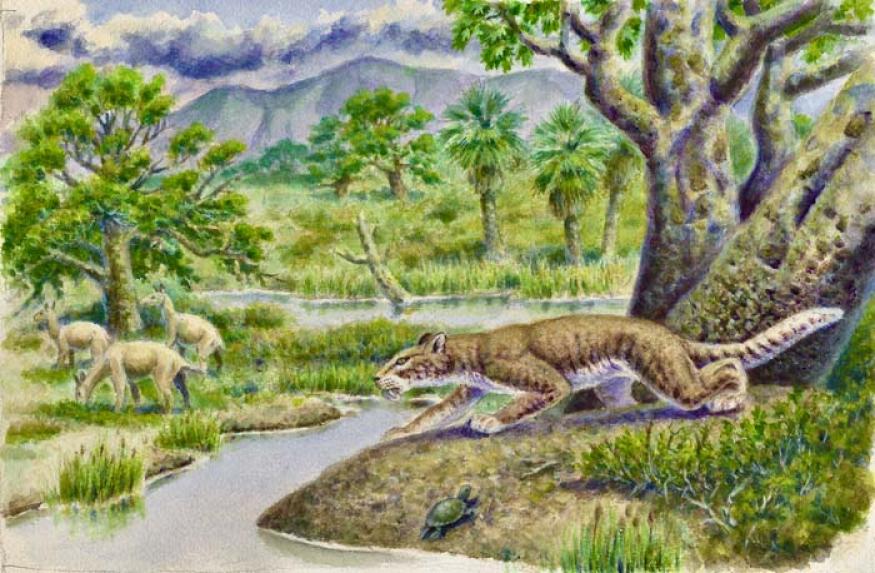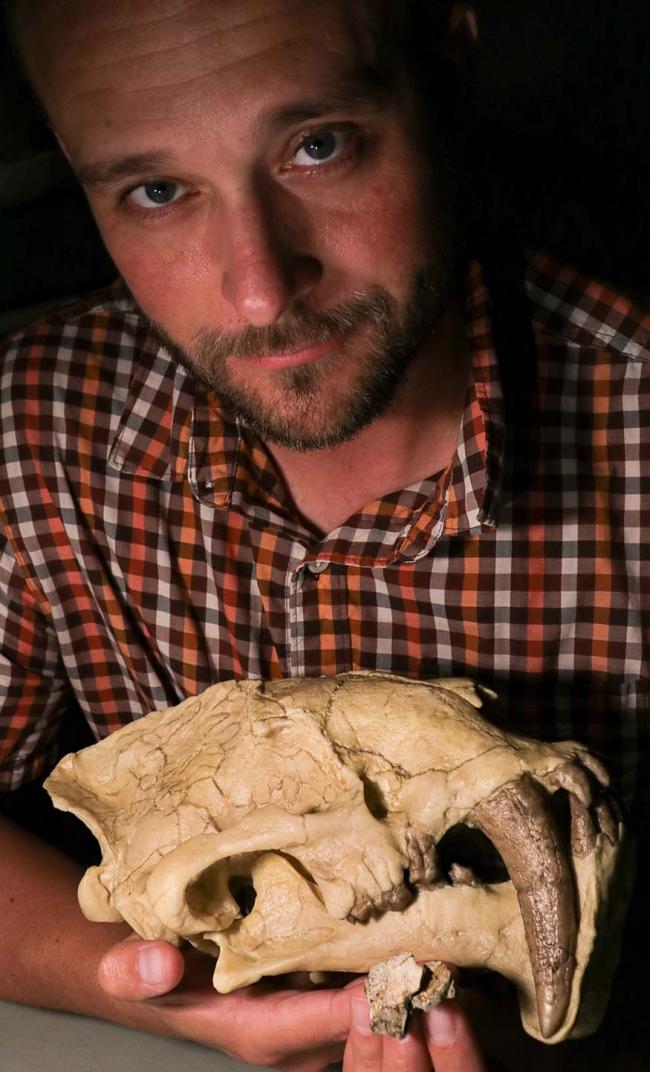
An artist’s impression of the cat-like Pangurban egiae. (Illustration courtesy Jim Melli/San Diego Natural History Museum)
Fossil's name recalls Augustana English class
A newly named 38-million-year-old catlike mammal will be called Pangurban egiae in honor of a scientist's fond recollection of his Augustana English class.
Dr. Ashley Poust ’06 has named the new species of sabretooth nimravid in honor of his class with Dr. Joseph D. McDowell, Augustana professor of English.

Dr. Ashley Poust compares the main Pangurban fossil to the more complete skull of its close relative Hoplophoneus. (C. Hansen/San Diego Natural History Museum).
"The name for the animal came directly from my time as an English minor at Augustana. I took a number of classes from Dr. McDowell and in one of them we learned about the 9th century poem "Pangur Bán," about a monk and his cat," Dr. Poust said.
"I have never lost my love for literature and history, kindled at Augustana. Fast-forward more than a decade and my co-authors and I were able to name this new species Pangurban after that same literary cat."
This is not Dr. Poust's first named fossil. He and his colleagues made worldwide headlines in 2020 for contributing to the discovery of a new species of feathered dinosaur in China.
"Ashley was (and has remained) one of my prized students because his curiosity and enthusiasm for the life of the mind led him down so many paths," said Dr. McDowell. "I'm thrilled with his success."
Dr. Poust, currently a research associate at the San Diego Natural History Museum, majored in geology and French at Augustana, with a minor in English. He earned a master's in earth sciences at Montana State University before going to the University of California, Berkeley, for a doctorate in integrative biology.
He is the lead author of the paper describing Pangurban egiae, "An early nimravid from California and the rise of hypercarnivorous mammals after the middle Eocene climatic optimum."
The original sabretooth carnivores
Dogs, cats and their relatives — existing and extinct — are members of Carnivoramorpha, a group of mammals in which saber-like canines have evolved twice.
Sabertoothed nimravids were early members of Carnivoramorpha, but dogs and cats did not evolve from them.
"Our specimen has serrated slicing teeth which have important similarities to later predators. The teeth tell us that close relatives of today’s living carnivores spread around the world earlier than we believed, and they diversified quickly when they reached new continents like North America," said Dr. Poust.
By about 40 million years ago, saber-like canines evolved in an ancestral nimravid. By about 16 million years ago, saber-like canines also evolved in an ancestor of a cat subfamily called Machairodontinae, which would give rise to the genus Smilodon, the best known saber-tooth, about 2.5 million years ago.
Nimravids were the original sabretooth carnivores among Carnivoramorpha.
Dr. Poust and his colleagues re-identified a fossil specimen collected in San Diego in 1997. Earlier, based solely on a partial upper jaw with only two intact teeth and missing saber-like canines, the specimen was misidentified as a Hyaenodon, a separate group of carnivorous mammals.
Further morphological analysis of the tooth shapes helped to determine that the specimen was one of the earliest nimravids dating back 37 to 40 million years.
The first nimravids possibly originated in Asia, and after migrating across vast land masses that are now today's continents, inhabited western North America.
"The discovery of Pangurban egiae reminds us how quickly invasion and adaptation can occur and the large role it has played in the history of life," Dr. Poust said
